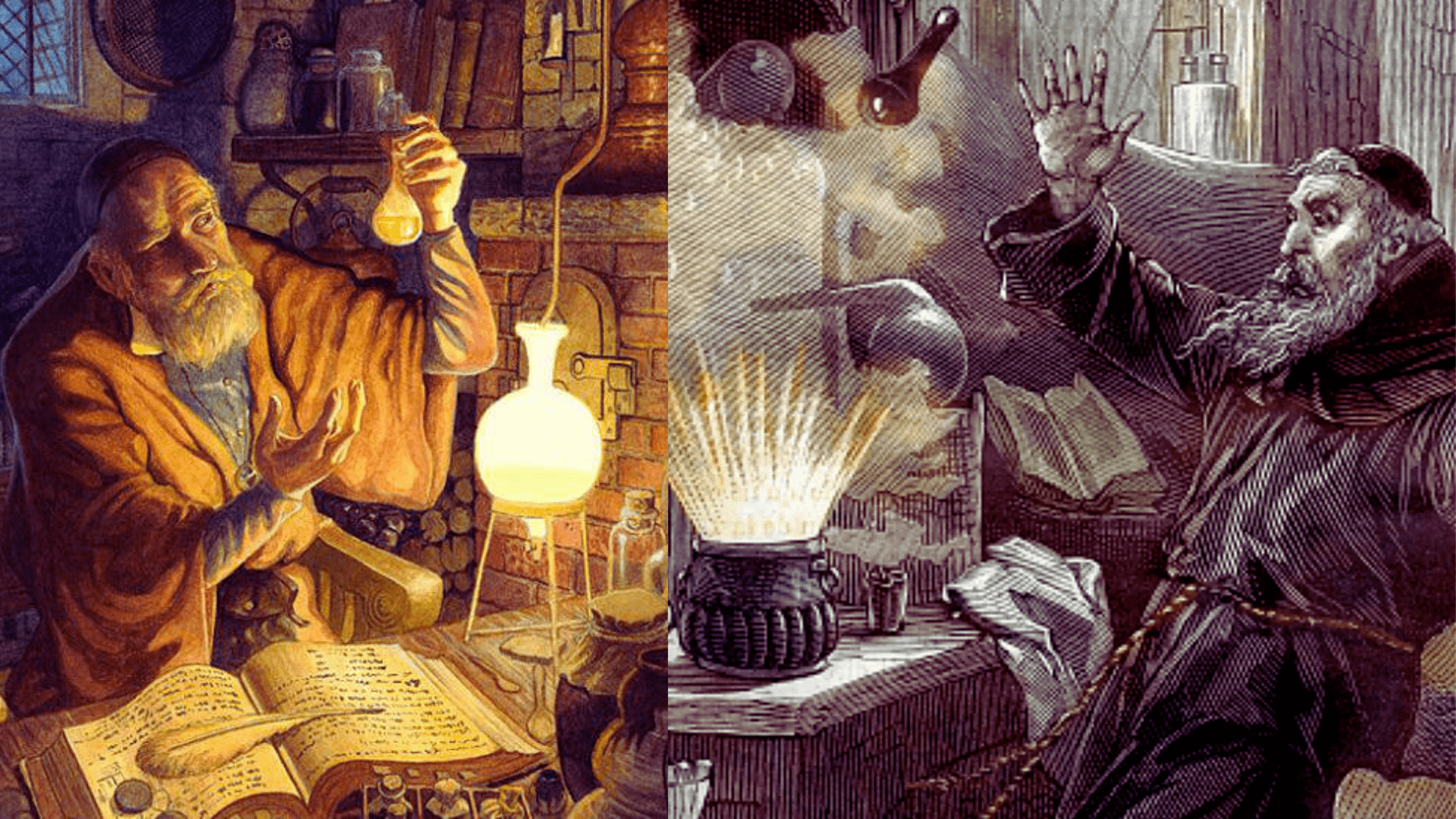Alchemy is an ancient branch of natural philosophy and protoscience that sought the transformation of base metals into noble metals, like lead into gold, and aimed at discovering a universal cure for disease and a means of indefinitely extending life. This practice was rooted in the mystical and the philosophical, combining elements of chemistry, physics, astrology, art, semiotics, metallurgy, and medicine. It was historically practiced in various forms in China, India, and the Western world. The central motif in Western alchemy was the philosopher’s stone, a substance believed to enable these transformations and grant the alchemist immortality. Alchemy served as a precursor to the modern science of chemistry before the establishment of scientific methods and principles.
The Origins of Alchemy
Ancient Egypt
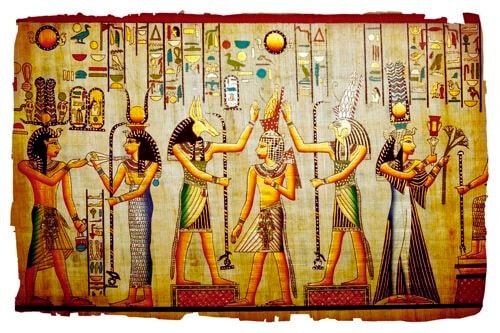
Alchemy in Ancient Egypt is considered one of the precursors to the alchemical traditions that later flourished in Greece and the Arab world. It began with the practical and mystical applications tied to their metaphysical beliefs, particularly concerning the afterlife and resurrection. The Egyptians’ deep connection with the spiritual world is reflected in their use of substances and processes to mimic the divine transformation and eternal life. The term “alchemy” itself possibly originates from the word “Khem,” the ancient name for Egypt, which is related to the black fertile soil along the Nile. The practices in Egyptian alchemy involved not only attempts to transmute base metals into more valuable ones but also the creation of potions and the consecration of objects with magical properties, reflecting a blend of chemistry, magic, and religion.
Hellenistic Influence
The influence of Greek philosophy and mythology on the development of alchemy during the Hellenistic period is profound. Greek alchemists, deeply embedded within their mythological and philosophical traditions, were instrumental in evolving alchemy into a more structured discipline. This period marked the transition of alchemy from simple practical experiments to a more complex system involving philosophical and mystical elements. The incorporation of theories about the four elements—earth, water, air, and fire—pioneered by Aristotle, played a significant role in alchemical practices. This theoretical framework provided a basis for alchemists to explore the transformation of materials, aiming to understand and manipulate their fundamental qualities.
The Hellenistic alchemists viewed their work as a blend of science and mysticism, with the laboratory acting as a temple where metaphysical transformations were akin to sacrificial acts. This sacred science was intertwined with visions and spiritual purifications, framing the alchemical operations as divine interventions.
The Philosophical Stone
Purpose of the Stone
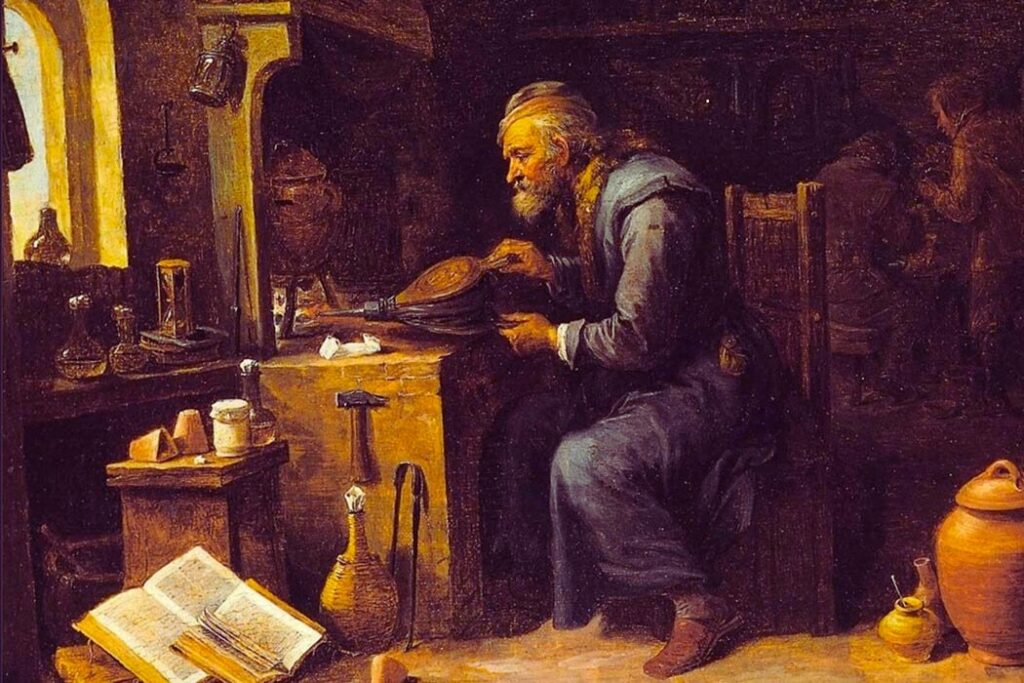
Alchemists primarily sought the Philosopher’s Stone for its reputed ability to transmute base metals into precious ones, such as turning lead or mercury into gold or silver. Beyond its materialistic applications, the Philosopher’s Stone was also believed to grant the elixir of life, which could potentially cure any illness and possibly confer immortality. The overarching goal was universal transmutation — the power to transform any substance into any other, providing perfect mastery over material elements.
Symbolism in Alchemy
In alchemical symbolism, the Philosopher’s Stone represents more than just a means to material wealth; it symbolizes achieving the ultimate in spiritual and physical perfection. Alchemists viewed the Stone as a key element in the transformation of base metals into gold, representing the transformation of the self towards a state of enlightenment or higher wisdom. It was thought to combine the four classical elements—Earth, Air, Fire, and Water—into a single magical element, indicating the unity of all things and the alchemist’s role in harmonizing these elements.
The Stone also held deep esoteric meanings, often depicted as the culmination of the alchemist’s magnum opus, or great work, suggesting not just the transformation of metals but the alchemist’s spiritual transformation. The symbolic representation is sometimes associated with the cosmology of alchemy, where material substances and their spiritual or inner qualities are integrated and reflected in the universe.
Alchemy in the Middle Ages
European Alchemists
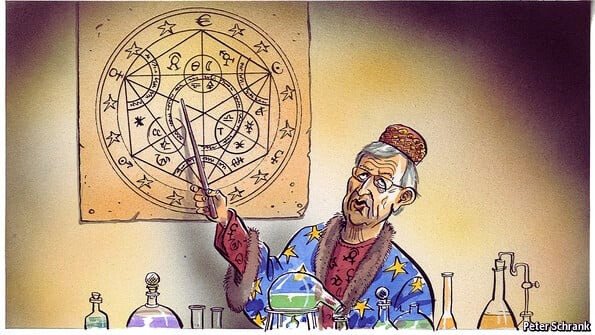
European alchemy saw several key figures who significantly contributed to the field both scientifically and philosophically. Here are some of the notable European alchemists:
- Albertus Magnus (1193–1280) – A medieval scholar who made extensive studies in alchemy and was one of the most famous precursors in Europe. He was known for his attempt to systematize alchemy and natural sciences.
- Roger Bacon (1214–1294) – An English philosopher and Franciscan friar who advocated for the empirical method of scientific study, which included alchemy as part of his investigations.
- Thomas Norton (pre-1436 – 1513) – An English alchemist whose work “Ordinal of Alchemy” is a significant literary contribution to the English alchemical corpus.
- George Ripley (c. 1415 – 1490) – Another important English alchemist, credited with composing “The Compound of Alchymy”. His work influenced many later alchemists in England and across Europe.
- Edward Kelley (1555 – c. 1597) – Known for his work as an alchemist and as an associate of Dr. John Dee, he was involved in scrying and spiritual conferences. He claimed to be able to turn base metals into gold.
These alchemists not only attempted to transmute base metals into gold but also explored metaphysical and philosophical concepts deeply interwoven with their practical experiments.
Islamic Golden Age
During the Islamic Golden Age, Islamic scholars made significant contributions to alchemy, which later laid the foundations for modern chemistry. Here are some key aspects:
- Practical Chemistry and Alchemy: Islamic scholars in the medieval Islamic world were engaged in both traditional alchemy aiming to transmute base metals into noble metals like gold, and the development of early practical chemistry for medicinal and industrial purposes.
- Jabir ibn Hayyan: Known as the father of chemistry, Jabir ibn Hayyan was a central figure in Islamic alchemy. He introduced the experimental scientific method to alchemy, inventing many types of now-basic laboratory equipment and identifying many chemicals.
- Al-Jildaki: He was another prominent scholar who contributed extensively to the field, particularly in refining the theories and practical processes of alchemy in Cairo.
These scholars and their methodologies significantly influenced both their contemporaries and later European alchemists, transferring knowledge that was crucial for the development of various scientific disciplines.
Alchemy’s Transition to Modern Science
The Scientific Method
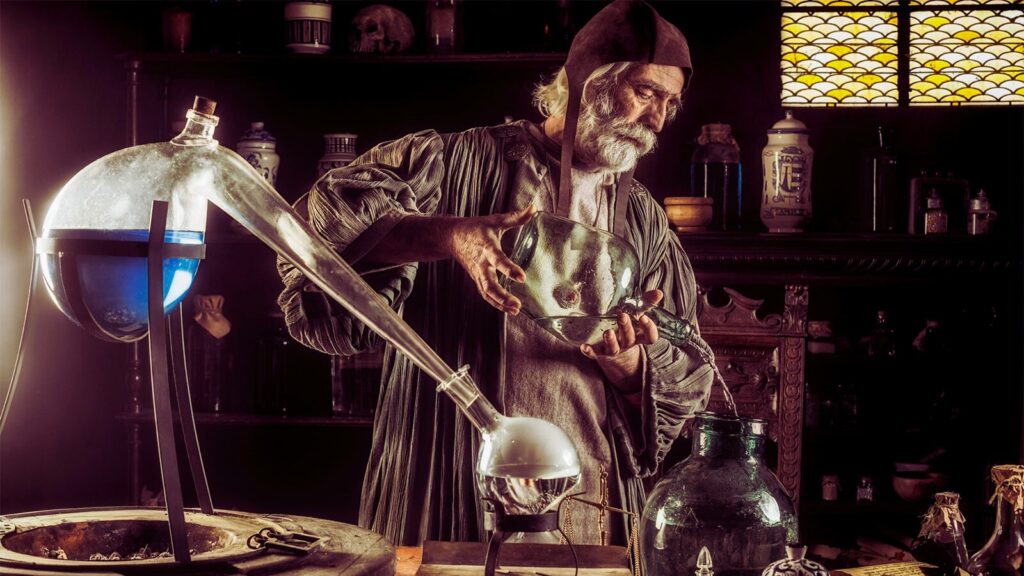
The scientific method, a systematic way of learning about the world through observation, experimentation, and hypothesis testing, has deep historical roots influenced by various cultures and scientific practices. Alchemy, particularly during the Renaissance and its earlier development in Islamic science, played a crucial role in shaping early scientific methodologies.
- Origins in Alchemy: Alchemists like Jabir Ibn Hayyan, often referred to as the father of chemistry, were pioneers in introducing experimental techniques to investigate the properties of substances. This practice laid foundational aspects of the scientific method, emphasizing empirical evidence and controlled experimentation.
- Renaissance Influence: During the Renaissance, alchemists’ work involved controlled experiments and the use of trial and error, which were critical to the evolution of scientific inquiry and directly influenced the formulation of the scientific method.
These historical interactions highlight how alchemical practices contributed significantly to the development of scientific methodologies, eventually leading to the refined processes that characterize modern scientific inquiry.
Key Figures in the Transition
The transformation of alchemy into modern chemistry was driven by several key figures who introduced empirical methods and scientific rigor into the study of substances. Some of the most pivotal scientists in this transition include:
- Sir Isaac Newton: While primarily known for his contributions to physics, Newton also delved deeply into alchemy. His work with alchemical texts and experiments influenced his thoughts on matter and its transformations, which later impacted his scientific theories.
- Robert Boyle: Often considered the father of modern chemistry, Boyle was a critical figure in moving away from the mystical aspects of alchemy to a more measured, experimental science. His work laid the foundations for the chemical revolution, emphasizing the importance of experimentation and the scientific method.
- Antoine Lavoisier: Known as the “father of modern chemistry,” Lavoisier discredited the phlogiston theory of combustion, which was rooted in alchemical thought, and introduced the Law of Conservation of Mass, a cornerstone of chemical science.
These figures, among others, were instrumental in shaping the scientific discipline of chemistry from the esoteric pursuits of alchemy.
Alchemy in Popular Culture
Literature and Movies

Alchemy features prominently in modern media, often symbolizing transformation and mystery. Key examples in literature and films include:
- Harry Potter Series: Alchemy plays a symbolic and practical role in the series, especially noted in the use of the Philosopher’s Stone and the concepts embodied by the Deathly Hallows. The series intertwines alchemical symbolism with the growth and transformation of its characters.
- The Holy Mountain (1973): This film explicitly incorporates alchemical motifs, representing a quest for enlightenment and spiritual transformation, directly mirroring the alchemical pursuit.
- Game of Thrones: The show integrates alchemical symbols and structures within its storytelling, reflecting on themes of power, change, and rebirth, often seen through the transformative arcs of key characters like Daenerys Targaryen and Jon Snow.
These examples showcase how alchemy, beyond its historical and scientific contexts, serves as a rich metaphorical layer in modern storytelling, enhancing narratives with themes of transformation and the quest for higher knowledge.
The Continued Fascination
The continued interest in alchemy can be attributed to several factors:
- Mystical and Spiritual Aspects: Alchemy encompasses more than just the physical transformation of materials; it also involves spiritual and mystical elements that continue to intrigue modern audiences.
- Historical Significance: Alchemy played a crucial role in the early development of scientific methods and chemical understanding. Its practices and theories helped lay the groundwork for modern chemistry.
- Religious and Philosophical Connections: The strong ties between alchemy, religion, and philosophy provide a rich tapestry that resonates with those interested in the intersections between science, faith, and the pursuit of knowledge.
- Cultural and Literary Influence: Alchemy features prominently in art, literature, and film, serving as a symbol for transformation and the human quest for understanding, which keeps it relevant in cultural discussions and creative works.
These factors ensure that alchemy remains a subject of fascination, despite the scientific advancements that have superseded its original goals.
The Spiritual Dimension of Alchemy
Inner Transformation

Alchemy serves as a powerful metaphor for personal growth and self-improvement, emphasizing transformation and refinement:
- Self-Improvement as an Active Pursuit: Alchemy symbolizes the proactive nature of self-improvement, where individuals must actively engage in transforming their own lives, akin to how alchemists worked to transform substances.
- Psychological and Spiritual Transformation: Carl Jung saw the alchemist’s work of turning lead into gold as a metaphor for personal and spiritual transformation — transforming the ‘lead’ of unexplored potential into the ‘gold’ of realized self.
- Emotional Alchemy: The concept of personal alchemy includes transforming negative emotions into positive outcomes, such as turning grief into healing or failure into wisdom, thereby achieving a state of inner ‘gold’ or enlightenment.
- Symbolism of Gold: In alchemy, gold represents the highest state of perfection, not just materially but also spiritually and psychologically, embodying the ultimate goal of human endeavor and inner richness.
These elements highlight how alchemy, beyond its historical pursuit of transforming base metals, serves as a deep allegory for the transformative journey of self-discovery and improvement.
Modern-Day Alchemists
Modern-day alchemists focus on spiritual alchemy, interpreting ancient practices as metaphors for personal transformation and self-actualization:
- Spiritual Self-Actualization: Practitioners of spiritual alchemy aim for self-actualization, using techniques to release limiting beliefs and heal past traumas as part of their transformative journey.
- Metaphorical Interpretation: They view traditional alchemical processes metaphorically, using them to convey deeper spiritual teachings and personal enlightenment.
- Occult Science and Transformation: Spiritual alchemy today often incorporates elements of occult science, utilizing a structured, seven-stage process to foster spiritual renewal.
- Deepening Sacred Connections: These alchemists work on deepening their relationship with the sacred dimensions of life, viewing the pursuit as a spiritual exploration rather than physical experimentation.
- Contemporary Practices: Practices such as meditation, visualization, ritual, and inner reflection are employed to achieve personal transformation and enlightenment.
Conclusion
Alchemy, once considered a pseudoscience, now enjoys a place of respect both in historical contexts and modern metaphysical discussions. Its legacy is evident not only in scientific methodologies and chemical discoveries but also in how we understand the process of personal and spiritual transformation.
Read also: What is Meta AI?
FAQs
Q. What was the ultimate goal of alchemy?
The ultimate goal was often the creation of the Philosophical Stone, believed to grant immortality and to convert base metals into gold.
Q. Did any alchemist ever succeed in making gold?
There is no verified scientific evidence that alchemists successfully made gold from base metals.
Q. How did alchemy influence modern science?
Alchemy contributed significantly to the development of the scientific method and chemical processes used in modern science.
Q. Can alchemy be practiced today?
While traditional alchemy is not practiced as a science today, its principles live on in spiritual and psychological contexts.
Q. Why does alchemy fascinate people even today?
Alchemy combines elements of science, magic, and spirituality, appealing to those interested in the mysteries of life and transformation.
